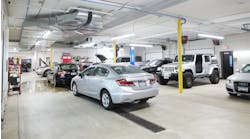Most customers — and many repair shops — don’t consider ride control replacement. Even with the average age of vehicles edging toward 12 years, most cars go to the scrapyard with their original shocks and struts.
| SYMPTOMS OF PHYSICAL DAMAGE THAT INDICATE NEW SHOCKS AND STRUTS MIGHT BE NEEDED |
Are there signs of physical damage that could compromise the ride control unit's ability to function as intended?
|
But ride control components do wear out, and service providers are likely leaving money on the table by not actively engaging consumers about the replacement of worn shocks and struts. Those consumers, meanwhile, are potentially experiencing degraded ride comfort, performance, stopping and stability in some driving situations, creating obvious safety concerns.
According to Bill Johnston, director of sales, North America Aftermarket at Tenneco, the primary reason ride control components are not replaced is because repair shops aren’t inspecting and recommending replacement. “During the course of the customer taking their vehicle in for service, unfortunately no one mentions it,” Johnston says. “They too often do not recommend ride control replacement.”
Johnston says repair shops could significantly increase their ride control business by educating their service writers and technicians, providing better information to new customers and going the extra mile to complete more jobs with existing customers. What’s more, that business can be gained with no new equipment or advertising expenses.
As the manufacturer of Monroe shocks and struts, Tenneco has developed a comprehensive education and training program called Safety, Service & Value to help shops improve their ride control business. “The goal is to get them to focus on products that wear out very gradually, since drivers don’t notice the change as much as they would with another component that might break or fail,” Johnston says. “That’s why these clinics are important. We educate the technicians and service writers to provide awareness to the owners so they are comfortable with inspecting and recommending ride control replacement.”
Six-figure opportunity
Training staff to educate customers about the value of ride control replacement could result in six-figure revenues, not including the alignment work and other services that often go along with ride control replacement.
Some industry estimates indicate that nearly 70 percent of vehicles keep their original shocks and struts through their end of life. “Much of that is because shops did not, in the course of regular maintenance, recommend ride control replacement,” Johnston says.
Depending on the shop volume and average customer mileage, there could be a significant opportunity to boost revenue by performing more inspections and recommendations. Even Tenneco’s conservative estimates put that revenue at roughly $124,800 annually based on performing 13 jobs per month. With the average installation costing roughly $800, shops could potentially see as much as $280,000 per year in additional revenue if they are able to close one more job per day (assuming four units are installed per job).
For older vehicles, this can be a difficult pitch. A high-mileage vehicle might have a resale value that is not that much more than the cost of new ride control components. Customers don’t know much about their ride control systems, and owner’s manuals rarely mention the replacement cycle for these components.
For vehicles in the right mileage window, however, shops can potentially double this business by following four basic steps. Below we’ve outlined a straightforward approach to selling ride control replacement that can help provide a boost in revenue with a minimal investment in time and training:
Step 1: Customer interview and assessment
Interview the customer to determine if they are a good candidate for new ride control components. According to Johnston, the sweet spot for ride control is a seven- to 10-year-old vehicle with 80,000 to 100,000 miles. “That ties into when most of these vehicles get another new set of tires,” he says.
When you encounter the owner of such a vehicle, take the time to explain the importance of the ride control system. Focus on how ride control products help to provide safe steering, stopping and stability. “The shock absorber or strut is designed to control suspension movement,” Johnston says. “It helps keep the tire flat on the surface so you get the best braking, control and steering. This really goes hand in hand with tires, which is why tire dealers sell a lot more ride control units.”
Ask the customer if they’ve noticed a change in how the ride feels. Find out how they use the vehicle, and determine if the original shocks have ever been replaced.
Shocks and struts don’t just help improve passenger comfort and the smoothness of the ride. They help improve vehicle control, prevent premature tire wear, reduce stopping distance under certain driving conditions, protect the front brakes and some suspension components from excessive wear, and help maintain proper wheel alignment. Many drivers wrongly believe these components will always last the lifetime of the vehicle. In truth, extreme temperatures and the high number of stabilizing actions a typical vehicle requires can wear down internal metal, rubber and plastic components as well as the shock fluid.
Once customers are aware of how the shocks and struts affect vehicle stability and performance, they are often more open to the possibility of replacing the units if they are indeed degraded.
Step 2: Road test
Next, road test the vehicle on a route that will provide a variety of pavement and surface conditions, wide and tight turns, and multiple stops. “We generally encourage a test drive to make sure the vehicle is handling properly,” Johnston says.
Before the test, check the tire pressure and ride height against manufacturer specifications. Pay attention to unusually harsh bumps, noises, and vehicle bounce and float, along with brake dive or acceleration squat. The technician should then report their findings to the customer.


